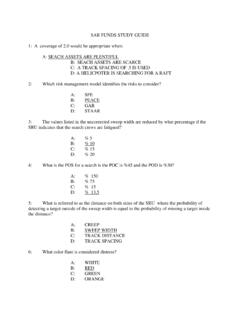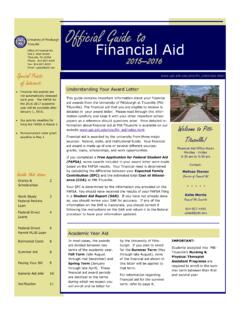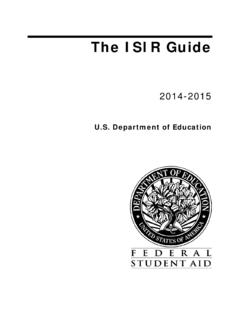Transcription of Money Laundering and Terrorist Financing in the Securities ...
1 Financial Action Task Force Groupe d action financi re FATF Report Money Laundering and Terrorist Financing in the Securities Sector October 2009 FATF Report THE FINANCIAL ACTION TASK FORCE (FATF) The Financial Action Task Force (FATF) is an independent inter-governmental body that develops and promotes policies to protect the global financial system against Money Laundering and Terrorist Financing . Recommendations issued by the FATF define criminal justice and regulatory measures that should be implemented to counter this problem. These Recommendations also include international co-operation and preventive measures to be taken by financial institutions and others such as casinos, real estate dealers, lawyers and accountants. The FATF Recommendations are recognised as the global anti- Money Laundering (AML) and counter- Terrorist Financing (CFT) standard.
2 For more information about the FATF, please visit the website: 2009 FATF/OECD. All rights reserved No reproduction or translation of this publication may be made without prior written permission. Applications for such permission, for all or part of this publication, should be made to the FATF Secretariat, 2 rue Andr Pascal 75775 Paris Cedex 16, France (fax +33 1 44 30 61 37 or e-mail: Money Laundering and Terrorist Financing in the Securities sector October 2009 2009 FATF/OECD - 3 TABLE OF CONTENTS EXECUTIVE SUMMARY .. 5 CHAPTER 1: INTRODUCTION .. 6 Introduction .. 6 Need for the Typology .. 6 Scope .. 7 Methodology .. 8 CHAPTER 2: LITERATURE AND ACTIVITIES REVIEW .. 9 Overview .. 9 Previous Typologies Exercises .. 9 International Activities and Materials.)
3 11 Domestic Material .. 12 Main Gaps in Existing Material .. 13 CHAPTER 3: ML/TF VULNERABILITIES IN THE Securities INDUSTRY .. 14 Introduction .. 14 Securities Products as Described in Questionnaire Responses .. 15 Vulnerabilities Associated with Particular Types of Securities Products .. 17 Markets and other Means of Access .. 22 Vulnerabilities Associated With Particular Types of Market Access .. 24 Payment Methods Relating to Securities Transactions .. 25 Entities Involved in the Offer, Sale, Advice, Management or Distribution of Securities ( Securities Intermediaries ) .. 30 Clients and Account Types .. 38 Determination of Value .. 42 Rogue Employees .. 44 Terrorist Financing .. 47 CHAPTER 4: PREDICATE OFFENCES FOR Money Laundering LINKED TO 48 Money Laundering and Terrorist Financing in the Securities sector October 2009 4 - 2009 FATF/OECD Introduction.
4 48 Insider trading .. 48 Market Manipulation .. 50 Securities Fraud .. 53 CHAPTER 5: SUSPICIOUS TRANSACTION REPORTING AND ENFORCEMENT ACTIONS55 Suspicious Transaction Reports .. 55 Enforcement actions .. 57 CHAPTER 6: CONCLUSION AND RECOMMENDATIONS FOR FURTHER WORK .. 58 General .. 58 Terrorist Financing .. 58 Money Laundering .. 58 STRs, Law Enforcement and Co-operation .. 59 Definitions .. 60 Issues for consideration .. 60 ANNEX A: GLOSSARY OF TERMS .. 64 ANNEX B: SUSPICIOUS INDICATORS .. 70 Introduction .. 70 ANNEX C: SUSPICIOUS TRANSACTION REPORTS .. 78 ANNEX D: QUESTIONNAIRE AND RESPONDING JURISDICTIONS AND ORGANISATIONS .. 80 Money Laundering and Terrorist Financing in the Securities sector October 2009 2009 FATF/OECD - 5 EXECUTIVE SUMMARY 1. The Securities industry plays a key role in the global economy.
5 Participants range from multinational financial conglomerates that employ tens of thousands of people to single-person offices offering stock brokerage or financial advisory services. 2. New products and services are developed constantly, in reaction to investor demand, market conditions, and advances in technology. Product offerings are vast, and many are complex, with some devised for sale to the general public and others tailored to the needs of a single purchaser. Many transactions are effected electronically and across international borders. 3. Some of the features that have long characterised the industry, including its speed in executing transactions, its global reach, and its adaptability, can make it attractive to those who would abuse it for illicit purposes, including Money Laundering and Terrorist Financing .
6 Moreover, the Securities sector is perhaps unique among industries in that it can be used both to launder illicit funds obtained elsewhere, and to generate illicit funds within the industry itself through fraudulent activities. Transactions and techniques associated with Money Laundering and the specific predicate Securities offences are often difficult to distinguish, which is why specific indicators and case studies for insider trading, market manipulation and Securities fraud are relevant and included in this study . 4. The case studies presented in this report illustrate the risks associated with the various types of intermediaries, products, payment methods and clients involved in the Securities industry. Unlike other sectors, the risks lie mainly not in respect of the placement stage of Money Laundering , but rather in the layering and integration stages.
7 Typical Securities -related Laundering schemes often involve a series of transactions that do not match the investor s profile and do not appear designed to provide a return on investment. 5. Some areas of vulnerability (for example, rogue employees) are not peculiar to the Securities industry, and thus this study is of relevance to the wider financial services sector. In particular, some Money Laundering schemes involve products and transaction types that exist in the banking and insurance sectors as well. 6. Suspicious transaction reporting in the sector remains relatively low, which can be explained by a number of possible factors, including a lack of awareness and insufficient Securities -specific indicators and case studies; issues that this report attempts to address.
8 Consultations with the private sector conducted for this project outlined the need for enhanced Securities -specific guidance by international organisations and national authorities. 7. The reported incidents of Money Laundering in the Securities industry far outweigh those relating to Terrorist Financing . However, the sector remains vulnerable to both Money Laundering and Terrorist Financing . Money Laundering and Terrorist Financing in the Securities sector October 2009 6 - 2009 FATF/OECD CHAPTER 1: INTRODUCTION Introduction 1. The Securities industry, along with banking and insurance, is one of the core industries through which persons and entities can access the financial system. This access provides opportunities for criminals to misuse the financial system to engage in Money Laundering (ML) and Terrorist Financing (TF).
9 2. Whilst the Securities industry has been the subject of international and domestic efforts relating to anti- Money Laundering (AML) and combating the Financing of terrorism (CFT) for several years, ML/TF vulnerabilities specific to this industry have not been subject to global typology research. Need for the Typology 3. The Securities industry evolves rapidly and is global in nature. It provides opportunities to quickly carry out transactions across borders with a relative degree of anonymity. It is thus imperative to highlight and share current information about potential vulnerabilities. 4. The report previously published by the FATF in 20031 on the Securities industry provided a relatively limited overview of ML/TF vulnerabilities due to the limited availability of Securities typologies.
10 In addition, MONEYVAL and the Asia/Pacific Group (APG) on Money Laundering , both FATF-Style Regional Bodies (FSRBs), have carried out work in this area. MONEYVAL published a Securities typology report in 2008 and the APG incorporated a section on Securities into its 2009 yearly typologies report. Both reports are limited in scope to those FSRBs regional jurisdictions. 5. The FATF decided to conduct a global study in June 2008 in order to better understand the ML/TF vulnerabilities in the Securities industry. It is anticipated that this study will be of benefit to the industry, law enforcement and regulators. 6. The need for this latest typology report is also driven by the comparatively low levels of suspicious transaction reporting in the Securities industry relative to other industries, such as banking.



















